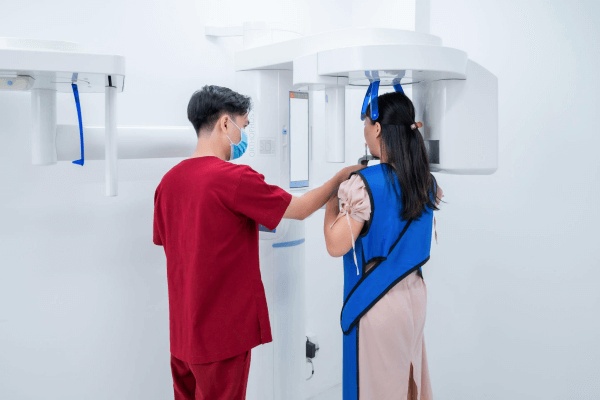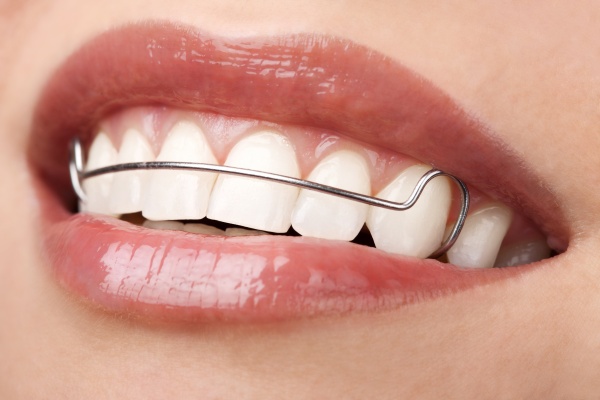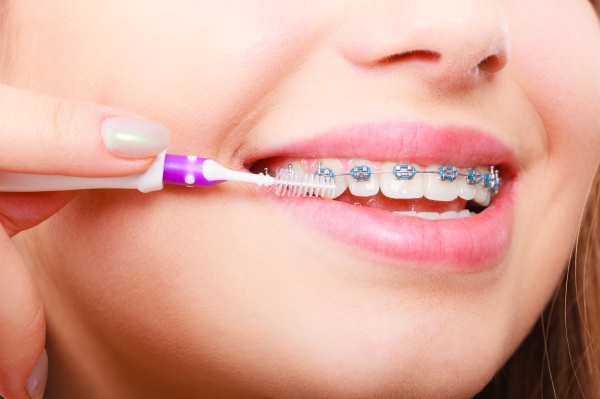Table of content
- 1. How long does braces treatment take, and what are the stages involved?
- 1.1 Stage 1: Initial examination before braces
- 1.2 Stage 2: Aligning teeth on the arch in the initial 2-6 months
- 1.3 Stage 3: Adjusting tooth axis over the next 3-6 months
- 1.4 Stage 4: Correcting bite and achieving balanced alignment for 6-9 months
- 1.5 Stage 5: Stabilizing and retaining the final alignment over the last 6-9 months
- 2. Factors affecting the duration of braces treatment
- 3. Is it advisable to remove braces early?
- 4. How to shorten braces treatment duration effectively and safely
- 5. Common questions about braces treatment duration
Braces are a popular method to correct crowded, misaligned teeth and jaw alignment issues. However, it involves a series of stages, leading many people to wonder how long the entire braces process takes and when they’ll start seeing results. Let’s dive into the details below!
1. How long does braces treatment take, and what are the stages involved?
The average braces treatment time is 24 months or more, divided into four main stages:
1.1 Stage 1: Initial examination before braces
Your orthodontist will conduct a comprehensive examination, discuss your goals, and review any dental history, such as past gum treatments, fillings, or periodontal issues that may need addressing. You’ll have photos taken (intraoral, facial), along with X-rays and cephalometric images. Based on the findings, the orthodontist will assess your misalignment and propose a treatment plan, along with an estimated treatment time.

1.2 Stage 2: Aligning teeth on the arch in the initial 2-6 months
Once the treatment plan is set, the orthodontist will begin using braces brackets and wires of increasing sizes to adjust the tooth alignment. This process helps guide each tooth into its correct position along the arch. During this phase, you may feel the pressure from the brackets and wires or the force exerted by clear aligners as your teeth begin to move according to the treatment plan.
1.3 Stage 3: Adjusting tooth axis over the next 3-6 months
In this stage, the arch alignment becomes more balanced. For cases of overbite or underbite, there is noticeable improvement in jaw structure and alignment, making the facial structure more balanced. The orthodontist may adjust the treatment plan based on the current alignment and tooth movement.
1.4 Stage 4: Correcting bite and achieving balanced alignment for 6-9 months
By this stage, teeth have moved into their intended positions but may still have a slight bite misalignment. The orthodontist will adjust both the upper and lower arches to ensure a properly aligned bite, achieving symmetry and harmony in the arch and teeth alignment.
1.5 Stage 5: Stabilizing and retaining the final alignment over the last 6-9 months
In the final stage of orthodontic treatment, the teeth are fully aligned, with correct positioning and a stable bite. The braces are removed, and you’ll begin wearing retainers to maintain the results, ensuring the teeth remain stable and that periodontal ligaments stay in place for lasting results.

On average, a braces treatment takes at least 14 months to complete. To achieve optimal results in this timeframe, it’s essential to follow the orthodontist’s instructions on wearing appliances, monitor any unusual signs, and attend scheduled check-ups for necessary adjustments.
How do I know if my teeth are moving during braces?
Throughout the treatment, you may notice signs that your teeth are shifting, including:
- Feeling gaps between certain teeth
- Experiencing occasional tooth pain
- Noticing that the braces feel looser than when you first wore them
2. Factors affecting the duration of braces treatment
With extensive expertise and years of experience, the orthodontists at Elite Dental share that the duration of braces treatment depends on several key factors:
2.1 Age of the patient
Today, with the advancement of modern technology, braces can be performed on both children and adults. However, in adults, the jawbone has fully developed, making it relatively more complex to achieve ideal alignment, which can result in longer treatment times. Meanwhile, in children aged 5-12, the jawbone structure is not entirely fixed, allowing for more effective results in a shorter timeframe. Therefore, age plays a significant role in the length of braces treatment; the earlier the treatment starts, the simpler the process.
2.2 Severity and condition of misalignment
For cases with mild to moderate misalignment, the treatment duration typically ranges from 1 to 2 years. However, for severe cases, such as overbite, underbite, or crowded teeth, the complete treatment might extend to 2-3 years. In some instances, extractions may be necessary before beginning braces to create space, making it easier for the teeth to move into their correct positions. Patients with oral health issues (such as infections or pain) may also require extractions as part of their comprehensive treatment, which can lengthen the overall treatment time.
2.3 Orthodontist’s expertise
Braces treatment is a specialized area in dentistry that requires a well-trained and experienced orthodontist. A skilled orthodontist can develop a precise treatment plan, closely monitor the patient’s progress, and make timely adjustments, helping to shorten the treatment journey and achieve the desired final results.

2.4 Orthodontic method
Currently, there are two primary methods of orthodontic treatment:
- Braces with brackets: This method uses brackets and wires to apply pressure and move the teeth. There are two main types: metal brackets (suitable for all cases but with lower aesthetics) and ceramic brackets (more aesthetic but bulkier and prone to breakage). The treatment time with bracket braces typically ranges from 1 to 2 years, although it can vary depending on the individual.
- Clear aligners: This approach uses a series of clear, removable trays instead of traditional brackets and wires. These aligners fit snugly over the teeth and apply pressure to move them according to the orthodontist’s plan. For cases of moderate complexity, the duration usually ranges from 1 to 3 years.
2.5 Oral hygiene habits during braces treatment
In practice, those who maintain good oral hygiene and a scientific diet can shorten their braces treatment time. To finish your orthodontic journey as soon as possible and achieve straight, aligned teeth, it’s essential to follow these guidelines:
- Limit sugary foods and carbonated drinks to reduce the risk of cavities.
- Avoid overly hard or sticky foods to prevent damaging the braces or disrupting the pressure applied by the wires.
- Brush at least twice daily with a soft-bristled or specialized toothbrush, use dental floss instead of toothpicks, and rinse with mouthwash regularly to remove plaque from teeth and around brackets.
- Attend follow-up appointments according to your orthodontist’s schedule.

3. Is it advisable to remove braces early?
Avoid removing braces unless directed by your orthodontist. Removing braces prematurely, before the orthodontic process is complete, can lead to teeth shifting back to their original positions, causing misalignment and bite issues, which could affect chewing and the aesthetics of your smile and facial structure.
When can braces be removed? The average duration for braces treatment is around 2 to 3 years. Once this time has passed, if the teeth meet criteria such as proper bite alignment, the midline of the upper teeth aligns with the face’s midline, teeth fit together harmoniously, chewing function is optimal, and facial appearance is balanced, your orthodontist will recommend removing the braces. |
4. How to shorten braces treatment duration effectively and safely
To reduce braces treatment time, it’s essential to choose a reputable orthodontic clinic, begin treatment early when misalignment is easier to correct, and consult your orthodontist for the most suitable treatment method. During braces treatment, following a balanced diet, avoiding harmful habits that affect the teeth, and attending scheduled check-ups with your orthodontist can also make a difference.
Of these factors, selecting a trustworthy dental clinic with experienced orthodontists is crucial for successful treatment. Elite Dental takes pride in its team of orthodontists with over 12 years of experience in both traditional braces and clear aligners, meticulously assessing bite alignment and jaw structure to create optimal treatment plans for each patient.

Elite Dental has successfully completed thousands of braces cases, with data carefully stored to help new patients view before-and-after results for a better understanding of the final outcome. Each year, the clinic also updates its technology and invests in cutting-edge equipment, such as the 3D Trios dental scanner, Clincheck software, and the Sirona X-ray machine (Germany), to facilitate faster braces treatment.
Before coming to Elite Dental, young patient T.T (12 years old) had some teeth growing inward due to a narrow upper and lower jaw, which caused crowding and misalignment. Her family decided to go with Elite Dental’s expert team for her braces treatment. After a committed 2-year journey, T.T now has straight teeth and a perfect bite, radiating a confident and beautiful smile. She was thrilled to finally have her braces removed, feeling that her 2-year braces journey was completely worth it.
Advice from Elite Dental’s orthodontists:
For children with early signs of misalignment, ages 5-11 are ideal for correction as jawbones are still developing, making adjustments faster and more effective. At Elite, children can receive early intervention treatments, such as EF appliances, from age 5, which can enhance the success of braces later on.
5. Common questions about braces treatment duration
Here are some frequently asked questions and answers to help you better understand braces treatment duration:
5.1. How long does it take to put braces on?
The process of applying braces is relatively quick, taking about 30-45 minutes for a single arch and 60-75 minutes for both arches if performed by an experienced orthodontist. However, factors like the severity of misalignment, the time taken to clean the tooth surface, and the orthodontist’s expertise can influence the time needed for each individual.
5.2. How long after getting braces do teeth start moving?
Teeth generally begin to move within the first 2 to 6 months after braces are placed. You may notice slight movement, especially in cases of crowded or misaligned teeth.
5.3. How long does braces treatment take for someone aged 30?
For patients in their 30s, braces treatment might last around 3 to 4 years, though it can be shorter, depending on the level of dental misalignment and jaw structure. For an accurate timeline, a consultation with a qualified orthodontist is recommended.
In summary, the duration of braces treatment depends on factors like dental condition, patient age, the type of braces used (metal or clear aligners), diet, oral care habits, and, importantly, the orthodontist’s skill level. Don’t hesitate—share your dental concerns with Elite Dental and schedule a consultation with our orthodontists today!







